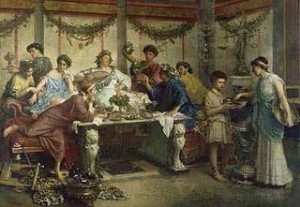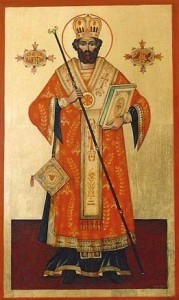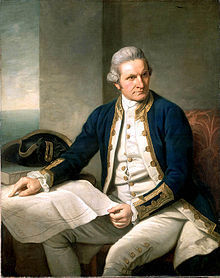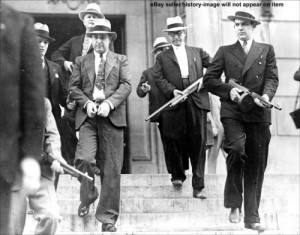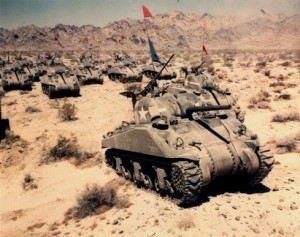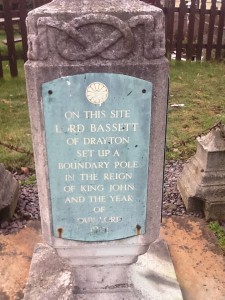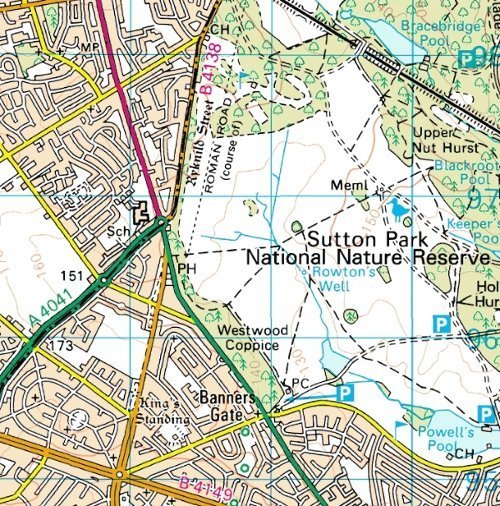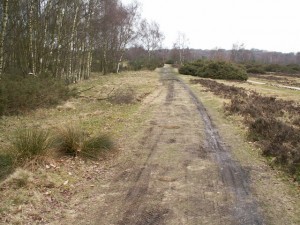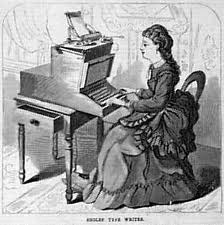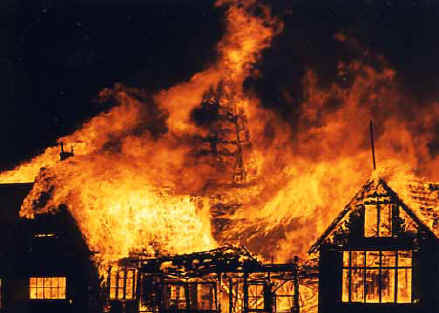Richard Denning's Blog, page 12
April 1, 2012
The origins of April Fool's Day
Have you been tricked this day by a prank or joke? Maybe you recall some famous tricks in the past. The BBC once broadcast a documentary of farmers in Italy picking spaghetti from bushes and trees after a bumper harvest. Thousands were tricked. In the USA Taco Bell announced it had purchased the Liberty Bell and renamed it the Taco Liberty Bell.
When though did this tradition start?
The suggestion, recorded in The Country Diary of Garden Lore, is that 1st April was the day that Noah sent a rook out looking for land as the flood waters subsided but where that comes from I cannot find out.
One explanation links it to ancient festivals such as the Roman Hilaria, celebrated at the end of March when people would dress up in disguises. There are theories that this time of year with its variable weather – sometimes cold, sometimes hot tricks men and makes us fools.
A more substantial explanation related to 1582, when France switched from the Julian calendar to the Gregorian calendar. This changed the start of the year from the last week of March/ 1st April as it used to be to January 1. because it took a while for this fact to becomes known and accepted people who celebrated the new year on 1st April were ridiculed. A paper fish called a "poisson d'avril" would be stuck to their backs to show they were fools. This is still part of present day French culture as shown in this satirical image:
In England the celebration came in about 1700 becoming more popular as the century went on. Britain changed calendars in 1752 themselves, which may have encouraged the tradition. The Scots celebrated a two day event (how come they often manage to get two days out of something we English get one day from!) Hunting the gowk day involved sending folk on wild goose chases or false errands, whilst Tailie Day involved pinning tails or notices to peoples backsides.
This morning my father recreated the spaghetti hoax in a picture he emailed me to show my son:
 Did you think up any good ones today? Or were you the butt of an April fool?
Did you think up any good ones today? Or were you the butt of an April fool?

March 24, 2012
March 24 1603 Elizabeth I Queen of England Dies
March 24th is the anniversary of the day in 1603 when the greatest queen in England's history so far (and a contender for most powerful monarch perhaps) died.
In 1600 Elizabeth, the last Tudor monarch, had been Queen for 42 years. Many in the kingdom had known no other monarch. At the height of her power during the triumph over the Spanish Armada in 1588, she had created an image of an almost immortal majesty. Yet in the latter years her influence and hold on power were weakening.
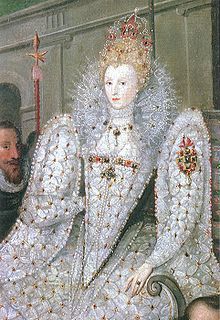
This was a period of unrest. Wars with Spain and conflict in Ireland rumbled on at great cost. This put a strain on the economy that was not helped by poor harvests. At the same time Elizabeth had become more hard line in her approach to religious non conformists – in particular Catholics. The 1590s had been an era of priest holes and raids in the night. Needing money to pursue her policies and not wanting to take it from a parliament who might impose restrictions on her she instead employed a system of patronage whereby she gained money from supporters in exchange for positions of power and influence and the granting of monopolies which made some men rich at the expense of many others and was a deeply unpopular policy.
She maintained an illusion of peace and tranquillity with a combination of propaganda and the suppressing of dissent by the use of a network of informers. Nevertheless support from parliament and the people was waning.
In these last years her senior advisor Robert Cecil began making plans for the succession. Elizabeth was not willing to discuss her choice of heir so Cecil had to move carefully. He approached James VI of Scotland who was descended from Elizabeth's grandfather, Henry VI via Margaret his daughter. He encouraged James to flatter Elizabeth and charm seemed to work because Elizabeth although not as such naming James as heir pretty much implied it.
In March 1603 Elizabeth's health deteriorated probably at least in part due to the death of close friends. She died on 24th and James was named King the same day.
James I
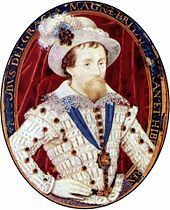
You can read more about this on this extended article A decade a week:1600 to 1609

March 4, 2012
What to think about when writing a Time Travel Novel
Time Travel is a popular element in hundreds of books, TV programmes and movies. If you fancy writing your own then here are a few ideas and questions to mull over.
Sci-Fi and Fantasy Novels still need rules
Just because a book is set in another world or in the future or involves time travel does not means you don't need to follow a set of rules. You can't just make it all up as you go along or people will soon get fed up with the chaos. In fact sci-fi and fantasy authors need to be able to explain to readers how THEIR world works because the reader does not know. To do this the writer must KNOW themselves how it all works. Made up worlds need more rules than the real world. So today I am going to look at Time Travel as an idea, in books and film and see the sorts of things you need to think about if using it in a story.
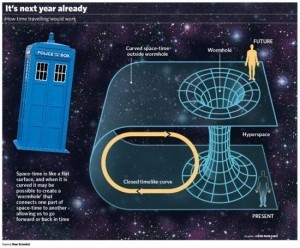
So how does time travel work?
The first choice you should make when planning a time travel novel is HOW exactly will time travel work.
Here are some possibilities:
•A machine or mechanism probably developed by a scientist or an advanced civilisation. So we have the Doctor's Tardis built by the Time Lords of Dr Who, H.G Wells' The Time Machine which was invented by a victorian scientist, and the car in Back to the Future)
•Divine intervention – There are ancient religious stories where people are taken from their own time and transported miraculously to other times.
•Magic – In a Fantasy world spells and incantations and magical devices can be the mechanism. An example would be the Time Turner in Harry Potter.
•Alien device – So advanced technology again but discovered by other people and used by them maybe without understanding it. In the Star Trek Episode "The City at the Edge of Forever" the crew use a portal left on a planet by ancient aliens to travel back in time.
•Psychic powers or projection. Maybe the characters have the ability to project themselves using the power of the mind.
•Biology – The travellers can generate an energy field which allows them to move through time. I use this mechanism in Tomorrow's Guardian.
•Physics – The travellers travel very quicky around a planet and the near light speed velocity and high gravity field SLOWS time down for them meaning they find them selves in the far future e.g The Planet of the Apes.
•Unexplained – The characters just find themselves in another time "somehow". Perhaps in a dream i.e. a Conneticut in King Arthur's Court.
Once a writer has some idea about the means of travelling through time that very means MIGHT provide a plot element. An example could be the car in Back to the Future. It uses nuclear fuel. So once Marty had gone back to 1955 he is in trouble as there is no readily available fuel about and they must work out some other method of getting him home.
What are the Opportunities?
Our time traveller could use time travel a variety of ways which themselves can create motives for the characters and elements to your plot.
Get Rich Quick – Maybe some time travellers spot the chance to grab an item which in the future is worth a lot of money. Septimus Mason in Tomorrow's Guardian is just such a character.
See The World – Or the universe. Consider all the wonders that no longer exist. Our characters may be time tourists on a tour of the highlights of history. It is also a chance for the writer to take the reader to some cool places.
Meet the Rich and Famous – Fancy meeting Napoleon, Elizabeth I or Marie Curie. Now you can. This gives you the chance to have the great figures as characters in your story. Maybe the characters are meeting them for a purpose EG to assasinate Hitler.
Change for the better - Maybe the charcters want to go back and change history for the better or for the worse. But who defines better?
[image error]
What are the Dangers?
Can you change history. Is it possible like in Back to the Future to prevent your parents meeting. Will you be wiped from existance?
Consider just how fragile Time is ni your world:
•VERY Fragile – tiny changes can have profound consequences. You squish a beetle in AD 1000 and somehow the present no longer exisits.
•Fixed – YOU CANNOT change history. No matter how you try.
•Resistant. You can change little things but the big things will still happen.
•Paradox Proof. The universe will protect itself. You try and kill your grandad before you are born and you can't find him, or the car misses him/ bomb does not go off etc.
Consider also what are the personal dangers of time travel.
•The past is dangerous
•You can get trapped in the past
•Do you know the language?
•Do you know the rules?
From these Dangers can come many of the challenges and obstacles to put in the way of your characters.
Just by thinking through these questions you can very quickly come up with all sorts of motivations for characters, problems and opportunities and there you have the start of a good Time Travel Story.
Tomorrow's Guardian

Tom Oakley experiences disturbing episodes of déjà-vu and believes he is going mad. Then, he discovers that he's a "Walker" – someone who can transport himself to other times and places. Tom dreams about other "Walkers" in moments of mortal danger: Edward Dyson killed in a battle in 1879; Mary Brown who perished in the Great Fire of London; and Charlie Hawker, a sailor who drowned on a U-boat in 1943. Agreeing to travel back in time and rescue them, Tom has three dangerous adventures, before returning to the present day. But Tom's troubles have only just begun. He finds that he's drawn the attention of evil individuals who seek to bend history to their will. Soon, Tom's family are obliterated from existence and Tom must make a choice between saving them and saving his entire world. Tomorrow's Guardian is a Young Adult Fantasy Novel.
Tomorrow's Guardian is a Time Travel adventure for Young Adults:
Time Travel Sounds like fun until you try it.

February 14, 2012
Valentine Day in History – not quite as nice as you might think
So here today is Valentine's day and full of cards and chocolates. Yet in history a number of not so nice things have occurred on this day. Let's start with the man the day is named after.
St Valentine
On February 14 around the year 278 A.D., Valentine, a holy priest in Rome in the days of Emperor Claudius II, was executed. One legend suggests that the emperor was struggling to recruit soldiers for his wars and believed if he banned weddings this might be easier as married men were reluctant to go away and fight. Valentine supposedly ignored the decree and married young couples anyway and so gained the emperor's wrath.
Another version has Valentine assisting persecuted Christians, hiding them, then helping them to escape.
Whatever he did to offend Claudius, Valentine's actions were eventually discovered. Valentine was arrested, beaten to death with clubs and his head cut off. The sentence was carried out on February 14. According to legend St. Valentine left a farewell note for the jailer's daughter, who had become his friend, and signed it "From Your Valentine."
In truth, the exact origins and identity of St. Valentine are unclear.
Captain Cook killed in Hawaii
On February 14, 1779, Captain James Cook, the great English explorer and navigator, is killed by the natives of Hawaii. Cook visited the islands three times. On the first visit they were treated with great respect by the locals. On the second visit they arrived during a religious holiday and it seems they were taken to be gods by the natives. Probably the Europeans rather took advantage of the situation but the illusion of their apparent immortality was spoilt when one of the men died.
Cook set off from the island but was forced back by storms. The natives now seem to have taken great offence probably because they realised they were taken advantage of, and attacked the sailors. Cook along with many of his men was killed in this attack.
The St. Valentine's Day Massacre
On February 14th 1929 four men dressed as police officers enter gangster Bugs Moran's headquarters in Chicago and line up seven of Moran's henchmen against a wall. They are in fact hit men working for Moran's main rival Al Capone. The hitmen open fire and shoot them to death. The incident became known as the St Valentine's Day Massacre.
It was the climax of gang wars between the two men. Moran's authority was now too weak to hold much power in the city and reverted to petty robbery and Al Capone himself would soon after be arrested for various crimes and sent to prison.
Battle of the Kasserine Pass
In their first major defeat since entry into WW2 the Americans in Tunisia are attacked on this day in 1943 by Rommel. Led by the Desert Fox, the Africa Korps break through the American lines and inflict over 1000 casualties in the next week's fighting.
So an eventful day in history but maybe not such a nice one as we hope the day has become associated with.
February 9, 2012
History at Bassetts Pole
I am often amazed at just how the most unlikely and uninspiring of locations can have historical connections and a story linked to them if you dig a bit. Crossroads and boundaries are often associated with some event in history – and this is not a surprise as it is JUST those kind of places that bring friends … and enemies together.
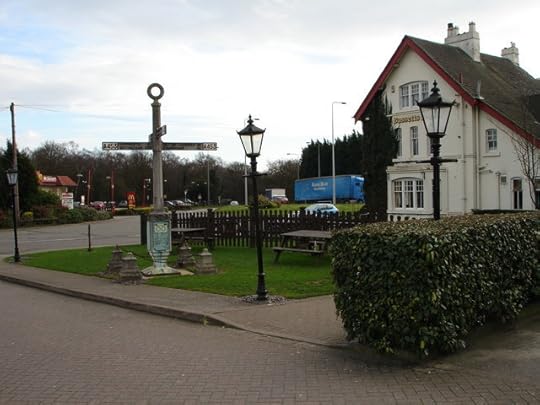
One such place is Bassetts Pole on the boundary of the West Midlands, Staffordshire and Warwickshire. Today it is a junction point where many roads meet and cross including the A38, the M6 Tollroad and the old A446 London road. There is a pub here and a Macdonalds restaurant. It is a spot where bikers gather in the summer and where they hold car boot sales. In nearby woods paintballers do combat.
All these activities take advantage of the transport links that bring folk past the spot. Other than the activities though the spot is far from attractive. It is a 'between place' and not somewhere to linger except for the activity you have gone there for. Even less is it a place that you would fight over – except with paint perhaps.
But once upon a time this was different. Men did fight and maybe die here. If we go back in time over eight hundred years to when it was all open heathland, a vague boundary existed here between the estates of the Bassett family who owned nearby Drayton Manor that of the De Frevilles who owned Middleton and the Grazebrooks of Shenstone.
The heathland was not exactly a useful means of marking a boundary and it seems that a dispute arose between the families. This dispute became violent and there are recorded episodes of several armed encounters at this spot between young men from the bordering estates.
Clearly something had to be done and in 1201 Lord Ralph Bassett (1160 to 1211) took action. He erected a pole at this spot to show where he felt the boundary should be. At this spot today there is a signpost engraved at the base:
The inscription reads: "On this site Lord Bassett of Drayton set up a boundary pole in the reign of King John and the year of Our Lord 1201″.
On another side is this:
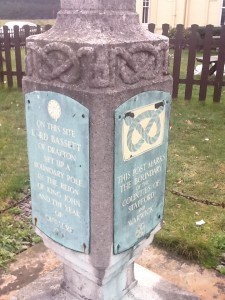 Stating that it was the boundary of Warwickshire and Staffordshire.
Stating that it was the boundary of Warwickshire and Staffordshire.
The pole became something that survived long after Lord Bassett's death. It was replaced and rebuilt over the years and indeed in the 19th centuries the Pole was tall enough to be visible for quite some distance. This enabled travellers to find their way across the heath.
The years moved on and on the advent of the motorbike age the pole became a gathering spot for bikers even as early as the 1920s. A night club opened here in the 20s called The Blue Lagoon and the 'Flappers' from Birmingham apparently enjoyed meeting the bikers here.
The Blue Lagoon became the HAPPY HOUR Transport Cafe in the 1930′s. In the late 1990s it was taken over by the McDonalds chain, and refurbished to its present 1920s Art Deco style
The Home Guard were stationed at this important road junction during WW2 and later a Tank testing track was built in the nearby Wood. The tanks and home guard are long gone but these days the woods and fields are home to the largest paintball attraction in the UK.
I find town and place names interesting and in this case – Bassetts Pole – it means what it says on the tin.

January 19, 2012
History is all around us – even in suburban Birmingham.
I work at a general practice that covers the areas of Great Barr, Streetly and Kingstanding in Birmingham. The area is suburban and full of not terribly inspired estates as well as council housing, playing fields and local shops and schools. As such the area does not have much to recommend it to those interested in history – or at least that seems to be the case. But dig beneath the surface and there are surprising historical remains that are reminders that all around us history happened.
King's Standing Bowl Barrow or Kingstanding Mound.
The two trees above are growing out of what today is a shallow bump in the ground not one metre tall and 20 across. Yet on 19 October 1642,during the Civil War, King Charles I is said to have addressed new recruits from this very spot. There is some dispute but it seems likely that it is after this that the name of the area – what is today called Kingstanding - was adopted. Alternatively there is some evidence that it was already called "The King's Standing" from medieval times. A Standing was a place where the king could wait to have deer driven past so that he could then hunt them.
None-the-less Charles stood here and spoke to his recruits and those same recruits then marched on down that road you can see to fight at the Battle of Edgehill only 4 days later.
The mound would have been much higher in ancient times but supposedly some years after the incident a new farm tenant levelled the mound. When he later heard from his neighbours of its royal associations he then rebuilt it .
Roman Road
That innocuous road is actually on or within a few yards of part of the Roman road to Wall (Letocetum near Litchfield) which is known as Rycknield Street. It crosses Wattling Street (today's A5) only a few miles away.
In Sutton Park you can walk along the Roman Road and there are spots where it can be clearly recognised.
The park contains a natural spring which it is believed was used by the Romans as they had a marching camp in the vicinity.
So you can see that in a small area there are several echoes and remnants of past times. Not as glorious as the great castles of course but still a reminder that history went on all around us.
January 10, 2012
5 Questions about Bernard Cornwell’s historical novels
5 Questions about Bernard Cornwell's historical novels
January 4, 2012
January – time for the book marketing and writing plan
I am a self published author and my sales in the little under two years since my first books came out whilst in the hundreds are not in the league of JK Rowling or Amanda Hocking alas. But I do have an approach that I feel is working for me. I am also a planner and an organiser kind of guy (I run the UK's largest hobby game convention for example and juggle the rota of 15 doctors over 4 sites in the day job) so the way I find I function best is to have a plan.
The plan does not always work and I do tinker, bolt on extra bits and drop sections at will. But once I have my plan I feel a lot saner! In a week or so I will sit down to work out my 2012 master plan and these thoughts will go through my mind:
My plan comes in three parts
A) Writing/publishing plan. I like to have an idea what I am aiming to achieve in the next 12 months. Without this I tend to find projects flit and float around. With deadlines in mind I can make it all happen. That's the idea at least;-)
Jan/Feb: Finish the editing of Child of Loki (sequel to The Amber Treasure) and pass to JO (my editor) for her magic.
Jan/Feb: New cover design for The Last Seal being worked on by Cathy Helms of Avalon Graphics and Gilian Pearce of Hellion's Art. (two very excellent people BTW and very talented).
March: Cover for Child of Loki to be finalised by Cathy.
April Child of Loki Published.
etc etc
b)Marketing Plan. This will be a complex look at all the areas of activities online and in the real world I will focus on this year. Not all areas will actually happen but I will identify activities to focus on.
• What sort of book do I have :
Be clear what category you book falls in. Have some idea of comparable books. Think: Why would a reader like your book?
• Think about Target Readers
Who are you aiming to sell the book to
Potential buyers:
Via Websites; Identify suitable online sales points
Retail outlets:
local books shops, ? any special shops eg a museum shop.
Audience at book fairs and literary events./ special visits
Consider where you might go to to make contact with potential buyers
• Reaching target readers: /Awareness Raising:
Complete following profiles and author pages. Add videos etc. be as active as possible:
Goodreads
Shelfari
Author Page on Amazon
Kindle Boards:
Niche market forums – eg Sci Fi and Fantasy ones
Virtual Book Tour.
Consider organising a blog tour
Blogging,
Use the blog to post interesting and useful articles and content that readers might want to look at.
Be active on Social Media eg
Twitter,
Face book.
Google +
Maintain E-book samples online
Freado, Scribd, Smashwords etc.
Maintain an active website
Try and keep fresh with content/ sneak previews, articles on aspects of the book and associated subjects.
Be active online
Research other forums and sites that focus on your genre and get involved. Try to get involved in chats, comments and not just advertise.
Audio and Video samples
Podiobooks.com ; U-tube reading of book
Visits
Contact Libraries and schools
Consider Hobby groups who might have an interest in your books.
Think about having a stall at Literary festivals, craft fairs, conventions etc if appropriate for your subject
Local radio and TV, local newspaper
Send out press releases and stories.
Try and obtain more Reviews
From book blog sites etc
C)Budget
These areas might need a budget:
Editor – do you need the book editing ?
Blog/Website: Design and maintenance, annual costs.
Graphics: Design of book covers, flyers, posters, bookmarks etc
Audio and Video: Do you need to buy a camera, earphones, microphone, editing software etc,
Printing: Consider printing bookmarks, postcards, flyers etc ,
Review Copies: Will you send out copies. If so they each cost a few quid including postage etc.
Travel costs, postage and other Expenses The list can go on but having an idea about planned costs for the year is sensible.
Anyway I am sure you all have your own ideas – many better than mine no doubt. Can you suggest any other areas to consider?

December 30, 2011
Rescuing Mary Brown from the Great Fire of London
Tom nodded and started forward, gathering his energy for moving them about fifteen feet up and across. Just as he was about to do so, Septimus grasped his shoulder and pointed to a window at one end of the top floor. The frightened face of a young woman had appeared at it. For a brief moment, she looked into Tom's eyes and then turned away and disappeared into the building. Did he hear a male voice calling her name: calling "Mary"? Fleetingly Tom recalled the dream: now was the moment.
"Got it, mate, right let's go!" Tom grasped Septimus' hand and Walked them both upwards and forwards. In his mind, he passed through the raging flames that engulfed the ground floor and up to the first floor. There, he and Septimus appeared at the end of the landing. Tom heard voices and turned to see a family group standing facing away from him at the far end. He spun round looking for a hiding place, but then jerked backwards as his companion tugged him by his collar into a room at the front of the house.
"Hush, we must not be found," Septimus whispered, holding his finger to his lips, "at least, not yet."
Tom looked about him; they were apparently in the baker's bedroom. There was a large low bed in the room with a cot at its foot, but otherwise it was pretty bare and Spartan; not even a rug on the bare floorboards. He thought back to his own room full of books, games, clothes and junk and was amazed at how little these folk had.
They heard a clattering on the wooden landing as the family came towards them, then halted at the top of the stairs leading down to the ground floor.
"What do we do?" A frightened woman's voice asked; "We can't get out. We will all be burned!"
There was the sound of children crying. They were terrified. No wonder, thought Tom – he was too. Then, a young man's voice shouted out.
"Quick, out the back of my room!" and there were more running footsteps as the family moved away, searching for an escape route.
"Right, come on!" Septimus ordered. They opened the door and went back out onto the landing. At the top of the stairs in the rear wall was a door leading into another room. From it, they could hear the voices of the family. Moving quickly to the door and peeking round it, they could see the children being passed up to a young man who was outside the window, balancing on the roof of the next house in the row. Only then did Tom recall that in his dream Mary had called the young man Jack. The baker and his wife moved past Jack and up onto the roof. As soon as they were safe, he came back to the window and was now encouraging Mary to join him. She stepped forward, but then appeared to lose her nerve and backed away from the window.
At that moment, fire surged up the stairs towards the two Walkers. Septimus cried out, then stumbled and fell hard onto the wooden floor, pulling Tom with him. Weakened by the fire from below, the wooden landing collapsed and they both fell through the hole.
Tom managed to catch hold of a ceiling beam as he fell, leaving him dangling down into the room below. Septimus landed with a crash on top of the baker's table in the middle of the room on the ground floor. Despite the inferno all around it the table was as yet intact. It was, however, smouldering.
"Septimus!" Tom yelled, but his friend did not respond and appeared to be out cold on the table below. The flames advanced on them both from all sides. Tom tried to Walk, but could not concentrate enough to focus on the Flow of Time. With a growing sense of despair, he felt the heat rise. His hair crackled and his shoes started to smoulder. Below him, one leg of the baker's table caught fire. The table creaked then, with a snap, the leg gave way and the whole thing collapsed, throwing Septimus' limp form onto the floor.
There was another roar and from the ends of the room two huge waves of fire swept towards them; at any moment it would surround them. This was it, Tom thought. Who would have reckoned he would die in the Great Fire of London? He braced himself, the muscles in his arm screaming at him to let go of the beam.
"STOP!" yelled a female voice from beside him.
What happened next, Tom would not have believed possible, had he not been hanging there waiting to be incinerated. It was as if someone had pressed the pause on a DVD: the banks of flame just froze. From the roaring further back, it seemed this effect was very local but, for a moment at least, they had a reprieve. What, Tom asked himself, had stopped the flames in that extraordinary way? He looked round and saw that right next to him, kneeling on the landing and peering down through the gap, was Mary Brown. Her face wore an expression of intense concentration. Still gritting her teeth, she slowly turned her head and looked into his eyes.
"Cannot hold it … much longer," she finally said, sweat running down her face.
Tom nodded. Explanations could wait until later. So, hanging on with one hand he reached down and pulled the long iron chain out of his belt and threw the end of it to Mary, who caught it and then stared down at him.
Tom yelled, "Hold this a mo!" and letting go of the beam he dropped down into the room below. The chain had enough slack so Mary could hold one end; the other end with its globe of water was still tucked in Tom's belt. He felt the searing heat from the wall of flame, halted in its tracks, but beginning to waver. Bending down he grabbed Septimus by the lapel then reached out to the Flow of Time, relieved to feel its presence once again. Just then, Mary, overcome by fumes, gave a grunt and fainted to the floor, the chain still clutched in her hands. At the same moment, the fire surged forward once more, reaching the table, which now erupted into flame.
As Tom pulled all three of them away, the landing above them collapsed and showered the ground with burning rubble. In the nick of time they had gone from the seventeenth century, forward three hundred and fifty years, away from the Great Fire and into the present day.
Tomorrow's Guardian is a Time Travel adventure for Young Adults:
Time Travel Sounds like fun until you try it.
Watch the Trailer:

